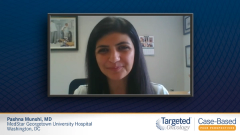
Introduction: A 58-Year-Old Man With Moderate Steroid-Refractory cGVHD and Risk Factors for cGVHD
Pashna Munshi, MD, discusses the treatment of a 58-year-old man who developed moderate steroid-refractory chronic graft-versus-host disease (cGVHD) after a stem cell transplant, and briefly reviews risk factors for developing cGVHD.
Episodes in this series

Case: A 58-Year-Old Man With Moderate Steroid-Refractory Chronic Graft-Versus-Host Disease
Initial Presentation
- A 58-year-old man previously underwent myeloablative conditioning and an allogeneic PBSC transplant for acute lymphocytic leukemia
- Received tacrolimus and methotrexate for GVHD prophylaxis
- At 10 months post-transplant, patient developed moderate muscle and joint pain with decreased range of motion, mild erythematous rash on cheeks
First-line Treatment
- Patient received topical steroid cream for rash, and was started on oral prednisone at 1 mg/kg/day
- After 4 weeks of treatment, the patient’s rash resolved but muscle/joint pain continued
Second-line Treatment
- Patient is now receiving ruxolitinib 10 mg orally twice daily, alongside 1 mg/kg/day steroids
Pashna Munshi, MD: A 58-year-old man previously underwent myeloablative conditioning and an allogeneic peripheral blood stem cell transplant for acute lymphocytic leukemia. He received tacrolimus and methotrexate for GVHD [graft-vs-host disease] prophylaxis. At 10 months post-transplant, the patient developed moderate muscle and joint pain with decreased range of motion, mild erythematous rash on his cheeks. In the first line of treatment, the patient received topical steroid cream for rash and was started on oral prednisone at 1 kg per day. After 4 weeks of treatment, the patient’s rash resolved, but muscle and joint pain continued. Second-line treatment, the patient is now receiving ruxolitinib [Jakafi], 10 mg orally twice daily, alongside 1 mg per kg per day of steroids.
This is a young man. He’s 58 years old, relatively young, and he’s undergone an intensive conditioning regimen called a myeloablative regimen, alongside receiving peripheral blood stem cells as the graft source from a donor. The case doesn’t tell us if the donor was unrelated or a related donor. But typically, when we look at risk factors for chronic GVHD, we have historical and consistent data now that show that the use of peripheral blood stem cell grafts, presence of prior acute GVHD, use of a female to a male donor, these are all risk factors for developing chronic GVHD, alongside mismatched donor transplants. This patient has those risk factors. Having a peripheral blood graft, he’s had already some acute GVHD in the form of rash on his cheeks, and he is at increased risk of chronic GVHD. Now most of the patients with chronic GVHD are diagnosed within the first year after transplant, but there are about 5% to 10% of affected patients who do not develop signs and symptoms until much later. And it’s not atypical for this man to develop some acute GVHD even 10 months down the road following a transplant. Also, we see that sometimes approximately 30% of chronic GVHD patients can be de novo presentation. They present without any preceding acute GVHD. In this case, it seems like he’s got some joint issues and range of motion that’s affected here, alongside an acute GVHD presentation of a rash. A bit of overlap with chronic GVHD going on.
Transcript edited for clarity.







































